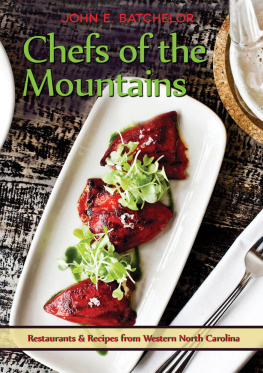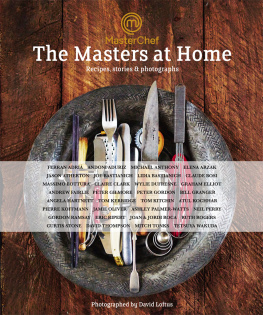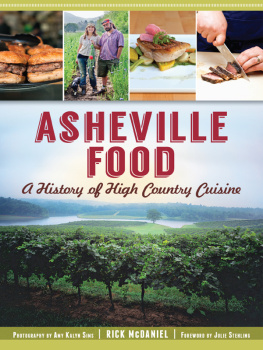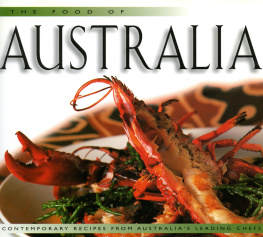
Chefs of the Mountains



JOHN F. BLAIR,
P U B L I S H E R
1406 Plaza Drive
Winston-Salem, North Carolina 27103
www.blairpub.com
Copyright 2012 by John E. Batchelor
All rights reserved, including the right to reproduce this book or portions thereof in any form whatsoever.
For information address John F. Blair, Publisher, Subsidiary Rights Department, 1406 Plaza Drive, Winston-Salem, North Carolina 27103.
C OVER PHOTOGRAPH
Pimientos de Piquillo by Chef Katie Button of Crate, Asheville / Photo by Peter Frank Edwards
F ACING P AGE
Lobster Ramen by Chef Nicholas Figel of Cyprus, Highlands / Photo by Clinton OBrien, Fonck Films
Photo from The Painted Fish, Banner Elk, by Heather Turner
P AGE ii, CLOCKWISE FROM TOP :
Randall Isaacs of The 1861 Farmhouse, Valle Crucis; Patrick Bagbey of Louisiana Purchase, Banner Elk; Michael Barbato of Chetola Resort, Blowing Rock; Nicole Palazzo of Sorrentos Bistro, Banner Elk
P AGE iii AT TOP :
Josh Emerline of Best Cellar, Blowing Rock; Sean Ruddy of High Hampton Inn and Country Club, Cashiers
P AGE iii AT BOTTOM, CLOCKWISE :
Judd Lohof of Caf Azalea, Asheville; Katie Button of Crate, Asheville; Damien Cavicchi of Biltmore, Asheville; James Welch of Green Park Inn, Blowing Rock
Library of Congress Cataloging-in-Publication Data
Batchelor, John E., 1947- author.
Chefs of the mountains : restaurants and recipes from Western North Carolina / by John E. Batchelor.
pages cm
Includes indexes.
ISBN 978-0-89587-581-5 (alk. paper) ISBN 978-0-89587-582-2 (ebook) 1. CooksNorth Carolina, WesternBiography. 2. RestaurantsNorth Carolina, WesternGuidebooks. 3. North Carolina, WesternGuidebooks. 4. CookingNorth Carolina, Western. I. Title.
TX649.A1B38 2012
641.50922756dc23
2012020466
10 9 8 7 6 5 4 3 2 1
Design by Debra Long Hampton


Contents
Preface
I am not a chef. I do not want to be a chef. Chefs put in too many hours on their feet, labor too late at night, and in general just work too hard. But I appreciate what chefs do, and I very much enjoy the products of their work.
That is the subject of the first section of each profile in this book. What sparked such a strong interest in cooking? How did that interest lead to a career? How did they learn, how did they train, who influenced them along the way, how do they approach their craft, and how do they create recipes? Some fascinating stories come to light here, from a young man who escaped East Germany barely a week before the Wall went up; to a chef who met his wife when a waitress told a group of women that the best dessert was not on the menu but rather the new guy in the kitchen; and to a young lady who left a rarified academic track to spend time in kitchens that led her into some of the worlds best restaurants.
The book is also about the restaurants where these chefs workthe concepts that underlie the establishments, the ambience they convey, what the menus offer, what is unique about the food. The mountains of North Carolina are home to some great restaurants, as well as some wonderful inns and hotels that serve excellent food. They are well represented in these pages.
Finally, although I do not want to be a chef, I would like to be able to cook like one on occasion for friends, for family, or maybe just for myself. That is what the rest of this book is about. The chefs have provided recipes characteristic of their restaurants, formatted for the home cook, with careful directions. The recipes range from the simple to the complex. Anyone can find something interesting and fun to cook in these pages. Ambitious cooks will have the means to replicate in their own homes dishes from some of the Southsindeed, some of the nationsbest restaurants. Careful attention is paid to presentation as well as preparation. These dishes will look professional on your table, in addition to having professional-quality taste. Chefs, restaurant owners and managers, and in some cases professional public-relations officers were given multiple opportunities to review relevant portions of my manuscript drafts and to check and recheck the content, especially the recipes. I often found that steps that are second nature to chefs need to be explicitly stated for home cooks. I hope readers find the directions logical and easy to follow.
In order to select chefs and restaurants for initial screening, I used participation in the Western North Carolina Chefs Challenge and the Fire on the Rock Chefs Challenge. The Western North Carolina Chefs Challenge includes the area in and around Asheville; information about the competition can be found at www.wncmagazine.com/wineandfood/tickets. Fire on the Rock focuses on restaurants in and around Blowing Rock and the High Country; information is available at www.fireontherock.com. I highly recommend these informative and entertaining events to anyone interested in food, cooking, and dining. My wife says my cooking improved noticeably after I started judging them. I also looked at chefs who have entered the Best Dish North Carolina competition (www.bestdishnc.com). Then I looked at several websites, including those of the Foodtopian Society, the Asheville Independent Restaurant Association, Carolina Epicurean, and Select Registry, as well as sites that rate restaurants, inns, and hotels. I also contacted restaurants recommended to me by friends, readers of my restaurant review columns, and other restaurant professionals. Of course, I also considered my own acquaintance with restaurants in the mountains.
A small number of restaurants I contacted said they were not interested..
No chef or restaurant paid anything to participate in this book. The information in the chef and restaurant profiles came from oral and written interviews, from restaurant websites, and in some cases from personal visits.
In the process of researching the book, I found a culture that is devoted to local foods. Given the rural nature of much of western North Carolina, that is understandable. But the chefs often revealed a passion for fresh ingredients grown or raised nearby that was stronger than I have encountered in other locations. It is fairly common to see farm to table off-menu specials prepared from local ingredients in restaurants throughout North Carolina and elsewhere. But in these pages, you will encounter restaurants that frequently organize their entire menus and core concepts around partnerships with local farms.
In addition to introducing the chefs and their restaurants, I use sidebars to describe 10 sample farms, cooperatives, and producers that I consider unique. I chose these particular operations either because chefs mentioned them by name or because I became familiar with them in the course of my research. I tried to include producers who sell directly to the public, from websites, at farmers markets, or from retail outlets. Consider using their products when you prepare these recipes.
Next page
















